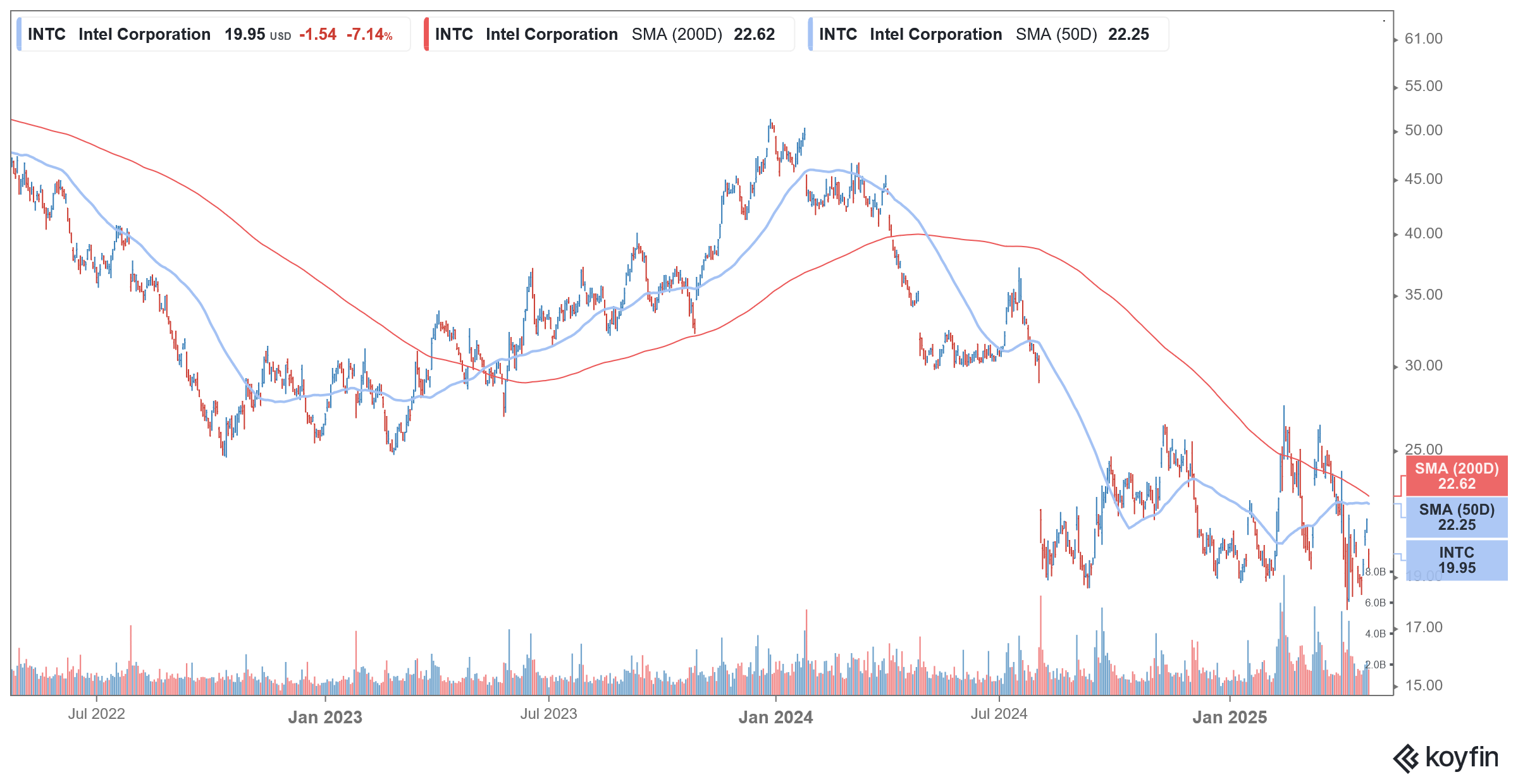Intel Stock Plunges as Tepid Guidance Overshadows Q1 Earnings Beat
Please note that we are not authorised to provide any investment advice. The content on this page is for information purposes only.
Intel stock (NYSE: INTC) is trading sharply lower as markets gave a thumbs down to its Q1 2025 earnings report. While the chip giant reported better than expected numbers for the quarter, it provided a tepid guidance which overshadowed sentiments.
Intel reported revenues of $12.7 billion in the quarter which was similar to the corresponding quarter last year. The company’s sales however easily surpassed the $12.3 billion that analysts were expecting.
Intel Reported Better-Than-Expected Earnings
Intel reported an adjusted EPS of 13 cents which was also ahead of the 1 cent that analysts were modelling. The company however posted a GAAP per share loss of 19 cents.
“The first quarter was a step in the right direction, but there are no quick fixes as we work to get back on a path to gaining market share and driving sustainable growth,” said Intel’s CEO, Lip-Bu Tan, Intel CEO.
He added, “I am taking swift actions to drive better execution and operational efficiency while empowering our engineers to create great products. We are going back to basics by listening to our customers and making the changes needed to build the new Intel.”
Notably, Tan joined Intel earlier this year after the company’s previous CEO Pat Gelsinger was abruptly ousted in December. Gelsinger was working on a turnaround strategy that did not go as plan and instead Intel shares fell to multi-year lows under his tenure.
Intel Provided Tepid Guidance
Meanwhile, while Intel’s Q1 earnings were better than feared the company’s Q2 guidance spooked investors. It forecast revenues between $11.2 billion-$12.4 billion in the current quarter which CFO David Zinsner admitted was “wider than normal” due to the uncertainty over tariffs.
“The current macro environment is creating elevated uncertainty across the industry, which is reflected in our outlook. We are taking a disciplined and prudent approach to support continued investment in our core products and foundry businesses while maximizing operational cost savings and capital efficiency,” said Zinsner.
He said that the tariffs make forecasting difficult while adding “The biggest risk we see is the impact of a potential pullback in investment and spending, as businesses and consumers react to higher costs and the uncertain economic backdrop.”
Recession Odds Have Risen
Zinsner also warned of a recession and said, “The very fluid trade policies in the US and beyond, as well as regulatory risks, have increased the chance of an economic slowdown, with the probability of a recession growing.”
Notably, several economists have raised the odds of a US recession amid the tariff uncertainty. While President Trump has lowered the reciprocal tariffs on other countries to 10% and has sounded reconciliatory towards China, a country he slapped with 145% tariffs, the uncertainty over the tariffs refuses to die down.
Intel to Cut Down on Capex and Expenses
Amid a tough macro environment, Intel is looking to slash its capex as well as operating expenses. The company has slashed its 2025 capex target by $2 billion to $18 billion while lowering the operational expenses target from $17.5 billion to $17 billion. The company is looking to cut its operational expenses by another $1 billion in 2026 also.
Among others, the company would slash its workforce to lower its cost base. “There is no way around the fact that these critical changes will reduce the size of our workforce,” said Tan said in a memo to employees. The cuts are set to begin this quarter and were preceded by massive layoffs in 2024. Additionally, Intel announced a work-from-office mandate for four days beginning in the third quarter.
Intel Is a Pale Shadow of Its Glorious Past
Intel, which was once the world’s biggest chipmaker, is now a pale shadow of its glorious past.
A lot went wrong with INTC over the last two decades. Perhaps, most importantly, it misread the smartphone market and turned down the offer to supply processors for the Apple iPhone. The company believed that Apple might not be able to sell enough of these, and it was a tiny market to bet on.
As things turn out, global smartphone sales now far exceed PCs and last year global smartphone shipments were 1.22 billion which is almost five times of PC shipments.
Intel was quite slow with innovation, and AMD gradually took its market share in the PC market. Apple, too, stopped using Intel chips for its Mac and instead pivoted to its chips.
Intel’s woes are far from over and Nvidia, AMD, and Qualcomm are looking to further eat its PC market share with Arm-based semiconductors. Intel is still working with its x86 technology that it created in 1981.
More recently, Intel seems to have lost out on the race in artificial intelligence (AI) chips, even as rivals, especially Nvidia, are printing money selling AI chips.
Tan Is Also Working to Turnaround Intel
Tan is also working on a long-term plan to turn around Intel and outlined the strategy during the earnings call. Firstly, he said that the company will focus on product development, stressing “best products always win.”
Secondly, he said that Intel will “refine” its AI strategy. “Our goal will be to take our integrated system and platform view to develop full stack AI solutions that enable more accuracy, power efficiency and security for our enterprise customers,” said Tan during the earnings call.
Thirdly, he talked about “building trust with foundry customers.” Gelsinger had big plans for Intel’s foundry business, but that segment has sagged and has been saddled with billions of dollars in losses.
Finally, he said that Intel will strengthen its balance sheet. He however said that the company has decided to not “spin off Intel Capital, but to work with the team to monetize our existing portfolio while being more selective on new investments that support the strategy.”
Analysts Slash INTC’s Target Price
Notably, reports of Intel being acquired have popped up quite often over the last six months and among other Arm Holdings was also said to have considered buying the company’s Products segment. So far, none of these have materialized and it remains to be seen whether Intel which was once the dominant chipmaker globally is acquired – either in whole or in parts.
Meanwhile, several brokerages slashed Intel target price after the tepid commentary on the Q2 guidance. Rosenblatt, which has a “sell” rating on INTC lowered its target price to a Street-low of $14. Among other brokerages, JP Morgan and Wells Fargo lowered their target prices by $3 each to $20 and $22 respectively, while maintaining their neutral rating.






